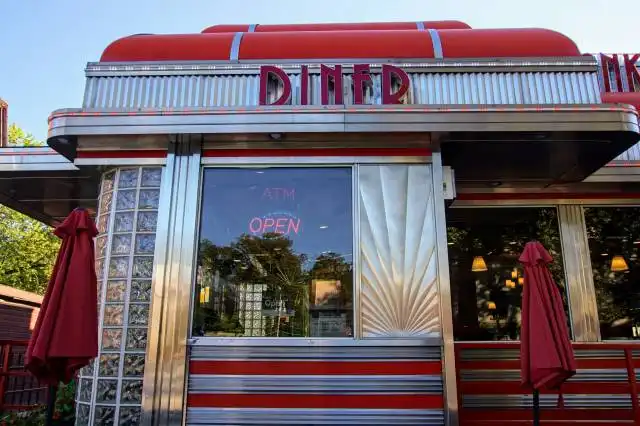Start a Family Style Restaurant
Creating Bonds and Memories: The Adventure of Launching Your Own Family Style Restaurant
| Updated


FAMILY STYLE RESTAURANT
Ever imagined turning your passion for hospitality and gastronomy into a profitable venture? Opening a family style restaurant is your golden ticket! A family style restaurant, as the name suggests, gives a welcoming ambiance much like sitting in a bustling family dinner, often offering a diverse set of dishes that can be shared among everyone. You’d be the magic hands serving warm lasagna, crispy chicken tenders, and that lip-smacking apple pie; ensuring all families feel a bit more close-knit, one meal at a time!
Jump to Business Plan
RELATED BUSINESS IDEAS
Browse ALL Food & Beverage Entrepreneurship Business Ideas
Discover Your Perfect Domain
Unlock the door to your online success with our hand-picked selection of premium domain names. Whether you're starting a new venture or rebranding an existing one, the right domain can set the tone for your digital presence. Browse through our curated list, each with its unique potential to enhance your brand's visibility and credibility.
FAMILY STYLE RESTAURANT MINI BUSINESS PLAN
This a quick reality check to help you identify the strengths and weaknesses of your business concept before you dive in.
Family-Style Restaurant Business Analysis
Expected Percent Margin:
- Gross Margin: Around 60-70%
- Net Profit Margin: Approximately 10-15%
Earnings Expectations:
- Daily Earnings: $800 - $1,500
- Weekly Earnings: $5,600 - $10,500
- Monthly Earnings: $24,000 - $45,000
- Annual Earnings: $288,000 - $540,000
Actions to Achieve the Figures:
Sourcing and Inventory Management:
- Initial Investment- Aim around $100,000-$300,000 for setup, furniture, kitchen equipment, and initial food supplies.
- Supplier Network- Build a strong connection with reliable food suppliers for quality ingredients at reasonable prices.
Marketing and Customer Acquisition:
- Local Marketing- Plan localized campaigns, sponsor local events, distribute flyers to attract the neighborhood crowd.
- Online Presence: Develop an engaging website and active social media presence.
Operations and Customer Experience:
- Staffing- Hire an efficient team comprised of cooks, wait staff, and cleaners.
- Menu- Including a variety of wholesome, delicious, family-friendly dishes.
- Ambiance- Maintain hygienic conditions and promote a warm, welcoming environment.
Cost Management:
- Operational Costs- Set target food cost percentage at around 25-35% of the final dish price for a good profit margin.
- Utilities and Maintenance: Budget around $1,000-$2,000 per month.
Business Operations:
- Opening Hours- Open 6 to 7 days a week serving at least two meals: i.e., lunch and dinner.
- Transaction Volume- Aim for an average check of around $30 with at least 40 transactions per day.
Remember, these are rough estimates and actual values will depend on the city, premises location, the restaurant size, cuisine, quality of ingredients, pricing, and strategies implemented.
NOT WHAT YOU HAD IN MIND? Here are more ideas



Browse ALL Food & Beverage Entrepreneurship Business Ideas
Grab Your Business Website Name
Before you get caught up in the whirlwind of setting up your business, invest in a domain name. It's a small but significant step that lays the foundation for your brand and makes it easier for customers to find and trust you. Just like you wouldn't build a house without securing the land first, don't build a business without securing your domain name.
"Why? Can't that wait?" Here's why it shouldn't
Step 1: Determine if the business is right endeavor
Breakdown of startup expenses
Before starting a family style restaurant, it is important to understand the startup costs that will be associated with the business. These costs may include the cost of the building or space, the cost of equipment, the cost of supplies and ingredients, the cost of staff, and the cost of marketing and advertising. It is important to research the costs associated with each of these items to ensure that the business will be able to cover the costs and still turn a profit.
Breakdown of ongoing expenses
Once the business is up and running, there will be ongoing expenses that must be taken into account. These expenses may include the cost of food and supplies, the cost of staff, the cost of utilities, the cost of marketing and advertising, and the cost of any repairs or maintenance that may be needed. It is important to research the costs associated with each of these items to ensure that the business will be able to cover the costs and still turn a profit.
Examples on ways to make money
There are a variety of ways to make money with a family style restaurant. These may include offering catering services, hosting special events, offering take-out and delivery services, and selling merchandise. It is important to research the different ways to make money with a family style restaurant to ensure that the business will be able to turn a profit.
Step 2: Name the business
When it comes to naming a family style restaurant, it is important to think of a name that will be easy to remember and will represent the type of food you will be serving. It should also be unique and memorable, so that customers will be able to find your restaurant easily. It is also important to make sure the name is not already taken by another business. To come up with a name, brainstorm ideas with friends and family, look up popular restaurant names, and research what other family style restaurants have named themselves. Once you have a few ideas, conduct a search to make sure the name is not already taken. Additionally, you should also consider registering the name with the local government to ensure that no one else can use it.
Step 3: Secure a location
When looking for the right location for a family style restaurant, it is important to consider the target market and the surrounding area. It is important to find a location that is easily accessible and visible to potential customers. It is also important to consider the size of the restaurant, the parking availability, and the cost of the rent. Additionally, it is important to consider the zoning laws and regulations of the area in order to ensure that the restaurant is in compliance with all local laws.
It is also important to consider the competition in the area. It is important to find a location that is not too close to other restaurants that offer similar services. This will help to ensure that the restaurant stands out and is able to attract customers. Additionally, it is important to consider the demographics of the area and the potential customer base. This will help to ensure that the restaurant is able to attract the right type of customers.
When looking for a location, it is important to consider the safety of the area. It is important to find a location that is safe for customers and employees. Additionally, it is important to consider the security of the restaurant. It is important to ensure that the restaurant is able to protect its customers and employees from any potential threats.
Finally, it is important to consider the cost of the location. It is important to find a location that is affordable and that fits within the budget of the restaurant. Additionally, it is important to consider the cost of any renovations that may be necessary in order to make the location suitable for a family style restaurant.
Step 4: Obtain the necessary licenses and permits
In order to open a family style restaurant, there are several licenses and permits that must be obtained. Depending on the state and local laws, the types of licenses and permits required may vary. Generally, the most common licenses and permits needed are a business license, a food service license, a health permit, a liquor license, a zoning permit, and a fire safety permit. It is important to research the local laws and regulations to ensure that all necessary licenses and permits are obtained.
How to obtain the licenses and permits
The process of obtaining the necessary licenses and permits can be complicated and time consuming. It is important to start the process early to ensure that all licenses and permits are obtained in time for the restaurant to open. The first step is to contact the local government office to determine which licenses and permits are required. Once the licenses and permits have been identified, the next step is to fill out the necessary paperwork and submit the applications. Depending on the type of license or permit, the application process can take several weeks or even months. After the applications have been submitted, the local government office will review the applications and issue the licenses and permits.
Cost of the licenses and permits
The cost of the licenses and permits can vary depending on the type of license or permit and the local laws. Generally, the cost of the licenses and permits can range from a few hundred dollars to several thousand dollars. It is important to research the cost of the licenses and permits before submitting the applications to ensure that the cost is within the budget.
Tips for obtaining the licenses and permits
When obtaining the necessary licenses and permits, it is important to be organized and patient. It is also important to read all of the paperwork carefully and to ask questions if anything is unclear. Additionally, it is important to keep copies of all of the paperwork and to follow up with the local government office if there are any delays in the process.
Step 5: Develop a menu
Creating a menu for a family style restaurant can be a daunting task. It is important to consider the type of cuisine, the budget, and the target audience when creating a menu. It is also important to consider the seasonality of the ingredients and the availability of local produce. It is important to create a menu that is both creative and cost-effective.
When creating a menu, it is important to consider the type of cuisine. Consider the type of cuisine that will be served and the target audience. Consider the types of dishes that will be served and the ingredients that will be used. Consider the types of flavors and spices that will be used and the types of dishes that will be served.
When creating a menu, it is important to consider the budget. Consider the cost of ingredients and the cost of labor. Consider the cost of equipment and the cost of supplies. Consider the cost of marketing and the cost of advertising.
When creating a menu, it is important to consider the seasonality of the ingredients. Consider the availability of local produce and the availability of seasonal ingredients. Consider the availability of organic ingredients and the availability of sustainable ingredients. Consider the availability of specialty ingredients and the availability of imported ingredients.
When creating a menu, it is important to consider the target audience. Consider the types of dishes that will appeal to the target audience. Consider the types of flavors and spices that will appeal to the target audience. Consider the types of dishes that will be popular with the target audience. Consider the types of dishes that will be unique and memorable.
Step 6: Hire staff
When it comes to hiring staff for a family style restaurant, it is important to find people who are passionate about food, customer service, and the restaurant industry. It is also important to find people who are reliable and have the right qualifications for the job. When hiring staff, it is important to conduct thorough background checks and interviews to ensure the right people are hired. Additionally, it is important to have a clear job description for each position and to provide training to ensure that staff are knowledgeable about the restaurant's policies and procedures. It is also important to provide incentives for staff to stay with the restaurant and to provide a competitive salary. Finally, it is important to provide a safe and comfortable working environment for staff.
Step 7: Market the business
When it comes to marketing a family style restaurant, there are a few key tips to keep in mind. First, it is important to create a strong online presence. This can be done by creating a website, setting up social media accounts, and creating a blog. Additionally, it is important to create a strong brand identity. This can be done by creating a logo, slogan, and other visuals that will help to differentiate the business from competitors. It is also important to create a strong network of contacts. This can be done by attending networking events, joining local business associations, and reaching out to local media outlets. Finally, it is important to create an effective advertising campaign. This can be done by utilizing traditional methods such as print, radio, and television, as well as digital methods such as search engine optimization, pay-per-click advertising, and social media advertising.
Step 8: Hire staff
Tips on how to hire staff
When it comes to hiring staff for a family style restaurant, it is important to find the right people for the job. First, it is important to create a job description that outlines the duties and responsibilities of the position. Additionally, it is important to create a list of qualifications that the ideal candidate should possess. This can include experience in the restaurant industry, customer service skills, and a friendly attitude. It is also important to create a competitive compensation package that includes wages, benefits, and other perks. Finally, it is important to conduct thorough background checks and interviews to ensure that the best candidates are chosen for the job.
Step 8: Develop a budget
Creating a budget is an important step when starting a family style restaurant. It helps to ensure that the business will be financially stable and successful. To create a budget, it is important to determine the startup costs and ongoing expenses. Start-up costs include the cost of the building, equipment, supplies, and any other necessary items. Ongoing expenses include rent, utilities, payroll, food costs, and other operating costs. It is also important to consider other costs such as marketing and advertising, which can help to bring in more customers.
Examples of ways to make money
When creating a budget, it is important to consider ways to make money. One way to make money is to offer discounts to customers who purchase larger amounts of food. Another way to make money is to offer catering services. This can be a great way to make money, especially during the holidays or other special occasions. Additionally, offering delivery services can be a great way to make money and increase customer satisfaction. Finally, offering discounts for large groups or for customers who come during off-peak hours can also be a great way to make money.
Step 9: Open the restaurant
Opening a restaurant is a big undertaking, and it can be a stressful process. It is important to plan ahead and be organized. The first step is to make sure that all of the necessary permits and licenses are obtained. This may include a business license, health and safety permits, and any other licenses that may be required in the area. Additionally, it is important to make sure that the restaurant meets all local and state regulations. Once all of the paperwork is in order, the next step is to find a suitable location for the restaurant. This should be a location that is easily accessible and has plenty of parking. It is also important to make sure that the location is in an area that will attract customers. Once the location is secured, the next step is to hire staff and purchase the necessary equipment and supplies. This includes everything from kitchen equipment to furniture and decorations. Finally, the restaurant should be advertised to the public and the doors should be opened for business.
EXPLORE MORE CATEGORIES
Browse ALL Business Idea Categories
TAKE THE NEXT STEPS










